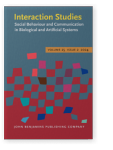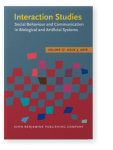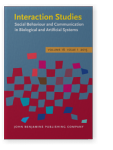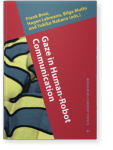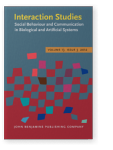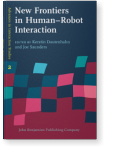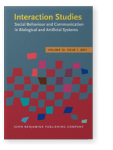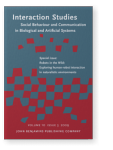Takayuki Kanda
List of John Benjamins publications for which Takayuki Kanda plays a role.
Journal
Book series
2016 Why do children abuse robots? Interaction Studies 17:3, pp. 347–369 | Article
We found that children sometimes abused a social robot placed in a shopping mall hallway. They verbally abused the robot, repeatedly obstructed its path, and sometimes even kicked and punched the robot. To investigate the reasons for the abuse, we conducted a field study in which we interviewed… read more
2015 The role of social eye-gaze in children’s and adults’ ownership attributions to robotic agents in three cultures Interaction Studies 16:1, pp. 1–28 | Article
Young children often treat robots as social agents after they have witnessed interactions that can be interpreted as social. We studied in three experiments whether four-year-olds from three cultures (China, Japan, UK) and adults from two cultures (Japan, UK) will attribute ownership of objects to… read more
2015 Can infants use robot gaze for object learning? The effect of verbalization Gaze in Human-Robot Communication, Broz, Frank, Hagen Lehmann, Bilge Mutlu and Yukiko Nakano (eds.), pp. 33–46 | Article
Previous research has shown that although infants follow the gaze direction of robots, robot gaze does not facilitate infants’ learning for objects. The present study examined whether robot gaze affects infants’ object learning when the gaze behavior was accompanied by verbalizations.… read more
2013 Can infants use robot gaze for object learning? The effect of verbalization Gaze in human-robot communication, Broz, Frank, Hagen Lehmann, Bilge Mutlu and Yukiko Nakano (eds.), pp. 351–365 | Article
Previous research has shown that although infants follow the gaze direction of robots, robot gaze does not facilitate infants’ learning for objects. The present study examined whether robot gaze affects infants’ object learning when the gaze behavior was accompanied by verbalizations.… read more
2012 What is the appropriate speech rate for a communication robot? Interaction Studies 13:3, pp. 408–435 | Article
This study investigates the influence of a robot’s speech rate. In human communication, slow speech is considered boring, speech at normal speed is perceived as credible, and fast speech is perceived as competent. To seek the appropriate speech rate for robots, we test whether these tendencies are… read more
2011 Validating characterizations of sociality in HRI: It’s more than psychometrics New Frontiers in Human–Robot Interaction, Dautenhahn, Kerstin and Joe Saunders (eds.), pp. 57–72 | Article
As the HRI field evolves, researchers increasingly seek to provide characterizations of sociality in human-robot interaction. But how does one assess whether the characterizations are valid? Using design work on “interaction patterns” as a case in point, this paper offers 5 approaches toward… read more
2011 Communication robots: Application challenges of human-robot interaction New Frontiers in Human–Robot Interaction, Dautenhahn, Kerstin and Joe Saunders (eds.), pp. 235–256 | Article
In this chapter, we discuss challenges in applications of communication robots. A communication robot is a robot that communicates with people in the way people normally do with each other. To date, there is no actual deployment of communication robots, hence researchers have been actively… read more
2011 Can young children learn words from a robot? Interaction Studies 12:1, pp. 107–118 | Article
Young children generally learn words from other people. Recent research has shown that children can learn new actions and skills from nonhuman agents. This study examines whether young children could learn words from a robot. Preschool children were shown a video in which either a woman (human… read more
2011 Attitudes toward robots and factors influencing them New Frontiers in Human–Robot Interaction, Dautenhahn, Kerstin and Joe Saunders (eds.), pp. 73–88 | Article
Attitudes toward robots, in particular, negative attitudes are important factors influencing human perception and behaviors toward robots. The chapter surveys the existing studies using the Negative Attitudes toward Robots Scale for measuring these attitudes, and then reports a current study based… read more
2009 Age differences and images of robots: Social survey in Japan Robots in the Wild: Exploring human-robot interaction in naturalistic environments, Dautenhahn, Kerstin (ed.), pp. 374–391 | Article
In order to investigate the influence of participants’ age on their image of robots in Japan, a pilot research was completed by 371 visitors (male: 124, female: 246, age: from 2 to 80 years) at a robot exhibition held at a commercial facility in Japan, based on the questionnaire consisting of four… read more
2007 What is a Human? Toward psychological benchmarks in the field of human–robot interaction Psychological Benchmarks of Human–Robot Interaction, Kahn, Jr., Peter H. and Karl F. MacDorman (eds.), pp. 363–390 | Article
In this paper, we move toward offering psychological benchmarks to measure success in building increasingly humanlike robots. By psychological benchmarks we mean categories of interaction that capture conceptually fundamental aspects of human life, specified abstractly enough to resist their… read more
2006 An approach for a social robot to understand human relationships: Friendship estimation through interaction with robots Interaction Studies 7:3, pp. 369–403 | Article
This paper reports our research efforts on social robots that recognize interpersonal relationships. These investigations are carried out by observing group behaviors while the robot interacts with people. Our humanoid robot interacts with children by speaking and making various gestures. It… read more
2006 Measurement of negative attitudes toward robots Interaction Studies 7:3, pp. 437–454 | Article
A great deal of research has been performed recently on robots that feature functions for communicating with humans in daily life, i.e., communication robots. We consider it important to develop methods to measure humans’ attitudes and emotions that may prevent them from interaction with… read more
